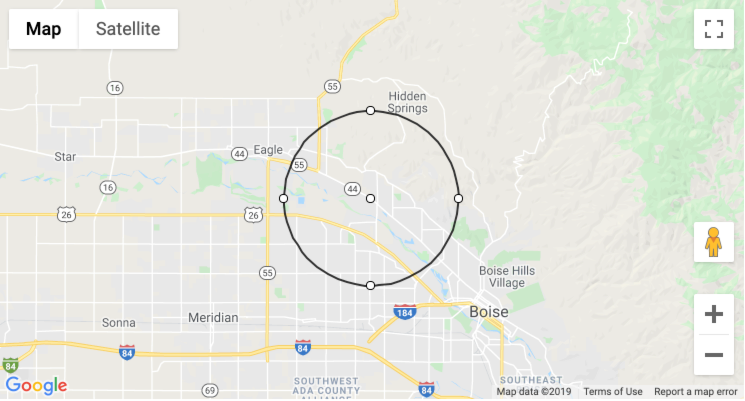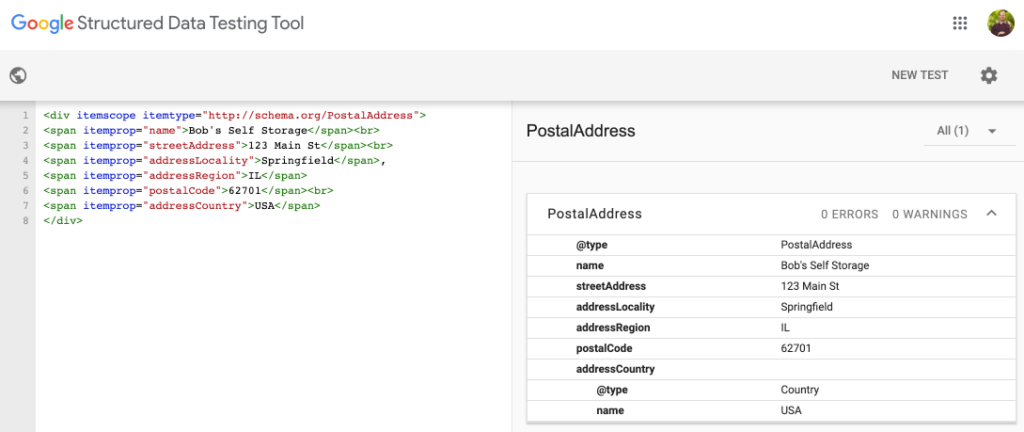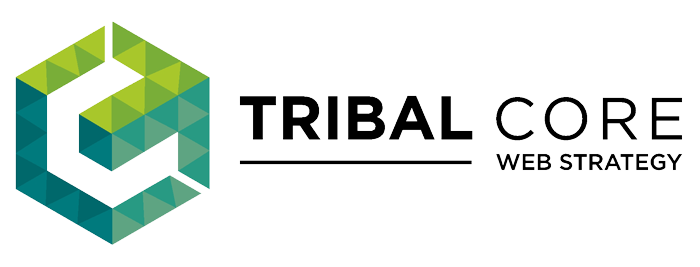UPDATED July 2, 2024
What is Self Storage SEO? Self Storage SEO is the process of optimizing the website of a self storage facility so that it has increased search engine visibility for relevant queries such as “storage units ventura ca” and “climate control storage near me.”
Why is Local SEO is so important for Self Storage facilities? Self storage facilities serve a customer base that largely lives within a 3 to 5 mile radius, depending on the type, quantity and density of nearby housing. This is similar to audience targeting for a restaurant, which might target customers within just a mile or two in urban areas, and an expanded radius in more rural and suburban areas. There may be other unique factors that affect a storage facility’s geographic target such as a military base or university or recreation area nearby.
That customer radius may also differ depending on the location offering other types of storage, such as boats and RVs, or serving other markets such as contractor storage or wine storage. Some owner-operators may also factor in density and income, such as appealing to nearby multifamily residential properties. New construction would certainly consider current conditions and projected growth.
Thus a focus on local search engine optimization (known as Local SEO) may have the biggest impact in attracting new customers, whether the facility is stabilized or in lease-up.

Following is our Guide to Self Storage SEO in 2024. Most of these optimization steps are straightforward and can be accomplished by selecting a few key SEO and marketing tools, and simply putting in the time.
 However, a DIY approach to SEO isn’t for everyone. If you read the following, and your eyes glaze over, check out The Storage Agency, our agency built just for storage owner/operators! We’ll take great care of you and your self storage portfolio, so that you can attract the right customers, lease up and keep your occupancy rate high.
However, a DIY approach to SEO isn’t for everyone. If you read the following, and your eyes glaze over, check out The Storage Agency, our agency built just for storage owner/operators! We’ll take great care of you and your self storage portfolio, so that you can attract the right customers, lease up and keep your occupancy rate high.
And be sure to read our latest article: How AI Affects Local Search for Self Storage. With AI rolling out, warts and all, Managed Local SEO has never been more important for local businesses of any stripe.
Much of this post can be applied to related services, such as “Portable Storage” (like PODS), “Valet Storage” and “Concierge Storage” as well. One difference is that those businesses may operate without a publicly-visible street address, which may play a part in Local SEO efforts (such as appearing on Google Maps or not).
Another option is to make online marketing a line item on your P&L. If you have marketing in your budget, look for a reputable, affordable web marketing firm with a focus on local SEO and data-driven results such as our dedicated company and team at The Storage Agency. Consider, too, if you’ll also need help with digital advertising via Google Ads, which not every SEO agency offers as a service. And consider whether you want an agency that is solely dedicated to the self storage industry. They’ll have insight into trends, benchmarks and performance across a portfolio of clients, which might help you deploy faster and get to a positive ROI quicker.
We know how competitive it is out there, even as the self storage footprint in the United States expands. Per Storage Cafe: Self storage has grown to more than 1.9 billion square feet of space in May 2024. Over the span of the last 5 years, 271 million square feet of storage space was built, equivalent to 14.5% of the total inventory. This is updramatically up from 2021, where 149 million square feet of storage space was builtcomposing 9.6% of total inventory.
In the section on LinkedIn below, you’ll find a handy 20-point LinkedIn Checklist we’ve created that you can download for free. Just click through to the Google Sheet and make yourself a copy.
Self Storage SEO Guide – Table of Contents
- Mobile Responsive Website
- Business Listings/Citations
- Reputation Management
- Local Community Backlinks
- Blogging and Content Strategy
- Keyword Optimization
- Google Business Profile
- LinkedIn Company Page
- Local Digital Advertising
- Location Schema
- Page Experience
1. Mobile Responsive Website

Why a mobile-friendly site is essential for a storage facility.
Self Storage SEO starts with a solid website that is accessible to users on any device, be it desktop, laptop, tablet or mobile. While management companies and REITs such as Public Storage and Extra Space Storage may create a single profile page or mini-site for each of their facilities, it can be useful for the facility itself to have its own website for additional online visibility. Having multiple brands under one management umbrella should be taken into consideration as well. Think of it as owning digital real estate in the search results!
If you use the browser on your cell phone, you know if a website looks good or not. On a “mobile-friendly” site, you can read everything clearly, within the margins of the screen, and the buttons are easy to press. You don’t have to scroll left-to-right, nor do you have to pinch-and-zoom to see all the contents on the page such as tiny text, nor are images, buttons and text cut off by the edge of the screen. You’re looking at a modern “mobile responsive” version of the website.
In 2024, this is practically universal, because any theme (the look and feel) that you want to apply to your website is going to be mobile responsive going in. If you’re working with a storage website development firm or storage management platform such as StorEDGE or Easy Storage Solutions, you’ll have a responsive website right out of the gate.
That said, many, many small owner-operators with just one or a few facilities may have a very outdated website that precedes the mobile era, if they have a website at all. We still come across sites that were built 15 or 20 years ago and desperately need to be modernized. If this is you, you might have less visibility online than you’d expect. In fact, Google just announced that they will no longer index websites that don’t work on mobile devices!
Having a mobile responsive site is critically important for self storage facilities. “Visibility is the single most important customer draw,” according to The Parham Group’s analysis of a typical self storage customer. Which means that when a prospect is exposed to the self storage brand, they are most likely driving by, with their cell phone on hand to get a phone number, check rates, view hours, etc.
While voice searches are increasing in frequency, and likely part of a future SEO strategy, having a mobile-responsive website remains critically important.
The website itself should have the unit sizes available, the rates, the phone number formatted as “click-to-call” and the address. There’s a lot more a self storage operator *can* do with a website, but it starts with the basics: mobile friendly with clear, accessible information for prospects and customers alike.
If the facility uses third-party software like ESS or SiteLink or StorEDGE to facilitate communications or bookings (or perhaps call for a pickup if using Valet Storage, Concierge Storage or Portable Storage), then that third-party software platform also needs to be mobile-friendly.
Even with COVID-19 largely in the rear-view mirror, we are seeing increased adoption of technology that facilitates hygiene and safety, such as contactless entry using a cell phone for verification, even if implemented under the broader umbrella of “unmanned” storage facilities. This, of course, may lower labor costs for owner-operators as well. Here’s an example of a self storage facility in Oakley, CA using an app for contactless gate entry.
2. Business Listings / Citations
How to expand your facility’s footprint across the web and get more visibility
Search Engine Optimization, or SEO, is not confined to the main website. Local SEO is the process of helping a business that serves a local clientele be found by that audience in organic search results. An important component of Local SEO is the development of business listings, or Citations, on business directories.
If you’ve traveled or searched for a restaurant, you’re familiar with these business directories – Yelp, TripAdvisor, YellowPages, BBB and many more. Google considers over 200 factors when determining the “authority” of websites and subsequent search results. In Local SEO, Citations are one part of an overall approach to creating search visibility for self storage. For more information, read our article published by Inside Self Storage on Local SEO for Storage Operations.
How to create Citations for a Self Storage facility? Creating Citations can be done manually or using a third-party Local SEO platform such as BrightLocal. The most important consideration in creating citations is to ensure consistency of data, so that the business details (such as name, address and phone number, aka “NAP”) match the website exactly. Or nearly exactly, as one site may show 123 Main Street and another may show 123 Main St. Google is intelligent enough to understand and parse these variations. We’d caution that simply setting up a profile on a third-party platform may be insufficient in managing all of the intricacies of proper Local SEO management, including Google Business Profile Posts, Google Suggestions, reconnecting broken Citations and more.
Secondarily, it is useful to fill out all of the fields that are made available, including business description, hours of operation and any specifics such as contactless entry or climate controlled units. Also be sure to include high-quality images formatted to spec. Those images may capture the business office, the units, the exterior of the building(s), the team members, drone footage and happy customers. The goal is to give prospective customers a good feel for the facility. You can also convey important attributes of trust and reputation.
And how about ChatGPT? What we’ve found in our research on AI is that Google is testing a significant overhaul of search results, via Bard, Generative AI and SGE (Search Generative Experience). These results are rolling out to general users and are known as AI Overviews. Sticking to fundamentals (clean data, increasing authority and steady acquisition of five-star Reviews) is the best bet for any self storage owner/operator navigating this new AI-driven landscape.
A side note here on AI – Google’s Core Update in March 2024 de-indexed thousands of websites, targeting AI-generated spam and prioritizing high-quality, human-generated content. Word to the wise, don’t assume AI is a silver bullet for content generation – humans (still) matter.
Lastly, we’d recommend building your visibility by appearing on podcasts, which can help establish your thought leadership while also building backlinks to your website from the podcast episode page. You can search on Apple Podcasts, or get in touch – we provide our clients custom, highly-targeted podcast research.
3. Reputation Management

How to stay calm and carry on when you receive a negative review
How to manage the reputation of a Self Storage facility? Another benefit of building Citations is to positively influence the facility’s online reputation. This is known as reputation management, which is an SEO function, because you are optimizing your presence on search engine results to the best of your ability and reach.
Similar and complementary to having a property website, building citations that you control may take up valuable “real estate” in the search results. This allows you to have some control over the overall profile of a business online.
Another component of reputation management is monitoring online reviews. Claiming and controlling business profiles on these third-party sites allows for effective response to user engagement. How businesses respond to both positive and negative reviews can greatly affect a user’s perception of that business.
For businesses in an industry such as self storage (or a mom-and-pop restaurant for instance), you can imagine how important it is to – first – offer great service and take care of issues so that customers are more likely to leave a great review. Secondly, it’s important to assess, mitigate and respond to any negative reviews as effectively as possible.
In some cases, a site may have an appeals process to contest a negative review, particularly if it seems “astroturfed” or left by a competitor. If you feel you fall into this bucket, use that to your advantage by appealing with a thoughtful, considered argument.
When a loyal customer leaves a positive review, they can be quickly thanked. If a negative review is left, that too can be quickly addressed in a non-confrontational way. Any prospective customer wants to see positive reviews and quick response from management to any potential issues. Everyone knows that businesses may occasionally get a bad review from a crank – it’s how you respond to the crank that gives a prospective customer peace of mind that they’ll be in good hands no matter what.
4. Local Community Backlinks

Be a part of the community – both online and offline
One of the more challenging aspects of SEO is the process of attracting and building links back to your website, known as backlinks. Not just any links are valuable – they should be from sites that themselves carry “authority.”
Because the customer base for a self storage facility is so localized within a 3-5 mile radius of the facility, backlinks from other local websites carry a lot of weight. A self storage facility is part of a local community and Google understands this!
We believe that the idea of any local business engaging with and supporting the local community is ethically the right thing to do, especially in such difficult economic times for so many families. It’s also a great way to raise visibility and build website authority.
Facility operators should start by ensuring full profiles on the websites of any local organizations of which they are a member. The local Chamber of Commerce is a great place to start, along with the county Economic Development organization. Other possibilities include state and regional Self Storage Associations and regional private/public initiatives.
Additional ideas for local backlinks include the following, with some of these ideas again viable with the pandemic largely under control:
- guest articles for the local newspaper – write about local events and things to do, such as a festival, fair or blood drive. Or profile a good citizen in the community.
- sponsoring a Little League or soccer team – we all know how much stuff families with kids collect. Gain some visibility for the self storage facility with a sponsorship, and be sure to agree on a link back from the Little League team website.
- paying or otherwise incentivizing a local blogger to cover the facility – consider piggybacking on other community news to propose something newsworthy, which might be an interview with the owner or manager.
- donate a unit to a local non-profit – many non-profits could use the extra storage, particularly if they are seasonal, such as a shelter. This may take on particular relevance in tough inflationary economic times. Reach out to your local Food Bank, they very well may need help!
- issue newsworthy press releases to the local paper and local bloggers – published releases with links are helpful, and can lead to additional press coverage, such as an interview or inclusion on a panel.
- membership in affinity groups – for instance, if the facility offers RV and boat storage, consider joining the local Boat Club to gain visibility with a target audience.
- storage facilities with an eco-friendly component (such as LEED certification or solar) might procure links from business directories and local news organizations who promote green businesses. (idea hat tip: Moz)
- attend local tech and business meetups, where attendees have a profile page on the website that organizes the event. Be sure to participate in the local events that can bring you visibility and business.
5. Blogging and Content Strategy
Blog posts should be local and focused on quality not quantity
You’ve probably heard that having a blog is important for search results. Well, yes, sort of. The reason this item isn’t listed #1 above is because the commitment to blogging for a self storage facility can be so challenging for a business that already operates as lean as possible.
Undertaking a content strategy should focus on quality, not quantity. Try creating resource pages that provide value to the local community and in particular the target demographic. Let’s say the self storage facility is in El Paso, TX near Fort Bliss Army Base. We know that military bases have a high usage rate of self storage facilities (PDF).
More than 1.5 million self storage units nationwide are rented to military personnel (6% of all units); however, in communities adjacent to domestic US military bases, military occupancy can be from 20% to 95% of all rented units.
Self Storage Association
Writing a thorough article on a frequently-searched, highly-relevant topic such as “hotels near fort bliss tx” may result in good traffic and backlinks from other sites. Any earned backlinks will build authority to that resource page, and to the entire website to a degree.
If this page becomes an “evergreen” post that consistently ranks at the top of results over time, update it every three months to ensure quality, comprehensive coverage and freshness. It’s less resource-intensive to “freshen” existing content than it is to create new content, so make it part of your content strategy.
Here’s another real-world example of how this works using a neighborhood guide put together by West Coast Self-Storage. By using their blog to cover the various neighborhoods in Everett, Washington, this self storage operator is getting in front of people that might be considering moving to Everett. It’s no coincidence that they have three storage facilities within a few miles of the city. Updating this for 2024 would ensure that searchers have the best and most recent information at their fingertips. In this case, the page was last updated over a year ago and may start seeing some drift in search results.
In both examples above, getting to the top of search results requires high-quality content (or even the best-quality content), good domain authority and probably a few backlinks. Maintaining those search results will likely require revisiting the post with fresh content on a fairly regular basis. How often? Perhaps every couple months for the content with the most competition.
6. Keyword Optimization
Why actual on-page SEO isn’t the most important thing you can do
Keyword optimization? Don’t sweat it. Really. Yes, we’re going against the grain here.
A single pass through the website, optimizing meta titles and meta descriptions for the facility and location on each page, is a great example of the 80/20 rule, where a small amount of effort produces the lion’s share of results.
Having an SEO professional conduct the initial single pass will be within any facility’s budget, and will get the facility much farther down the digital road. What a facility owner does not need is an expensive agency promising to “optimize the keywords” on an ongoing basis. This does not build site authority, which is a much bigger determinant of where the facility shows up in local search results.
The caveat here is that if you’re not ranking for a specific keyword (i.e. “24 hour access storage”) you might work that keyword and variations into your copy on the home page and other appropriate spots throughout the website. An example would be creating a new page of content on the website for a type of storage you offer but don’t rank well for, such as “contractor storage.” You can also create a Google Business Profile Post that also talks about this feature you offer.
What is Semantic Search?
Google is getting increasingly good at semantic search – understanding the intent of what someone is searching for, and the context of pages it may serve up in results. You no longer would derive any benefit from writing about your “self storage facility in Des Moines that serves self storage customers in the Des Moines metro area where there is a need for Des Moines self storage.” In fact, you could harm your position by writing “artificially” about your topic and audience. Write naturally for humans, using engaging and compelling copy that builds trust with your audience.
This will continue to evolve as AI is rolled out to search results, where searchers can build on previous searches to hone in on specific needs. For instance, Google will increasingly be able to accurately answer a query that drills down to a “storage unit near me with climate control, drive-up access and access to electricity with great reviews and the best prices.”
What About Self Storage Near Me?

A note about “near me” searches: they’ve skyrocketed in popularity the last eight years. We see a huge number of “storage units near me” and related searches in the Google Ads campaigns we run for our storage operator clients. Why?
- Increasing adoption rates of mobile devices
- The use of voice search
- The consumer expectation that Google or Siri will know what you’re talking about when you say “italian restaurant near me” or “starbucks near me” or “self storage units near me.”
As long as your site loads quickly, works great on mobile devices and develops increasing authority through quality backlinks, it will rank for relevant searches, including near me queries. Let’s put it another way – keyword optimization is not the low-hanging fruit here.
Also consider the adoption of new business segments such as portable storage, valet storage or concierge storage and how that affects your business. You might be able to expand your business to include valet storage. Or perhaps you can get ahead of competition by creating a financial model that shows why more traditional self storage is still the right fit for your target audience.
7. Google Business Profile
If Google gives your business a tool, use it! Google Business Profiles can give you an edge
A business should start or claim it’s Google Business Profile (formerly Google My Business) with all due haste. In 2024, it looks to be gaining in importance, particularly in terms of competing in Local Search.
Your Google Business Profile, or GBP, shows up as the “knowledge panel” of information in the right column of search results. It’s something you control as the “source of truth.” For instance, searching “the storage agency” brings up our panel of information, most of it controlled by logging into our GBP profile.
GBP managers should use all of the tools at their disposal, including accurate information, such as the storage unit sizes available, so that prospects know they can rent a 10×5 or a 10×30 storage unit to match their storage needs. And maybe a covered RV spot too!
We’d also recommend regular posting of events, news, specials, coupons and more. This includes still-useful new fields in the profile that allow for COVID-19 related information such as contactless entry, disinfecting procedures and temporary hours. Hey, may as well plan for the next pandemic!
Google has signaled the importance of Google Business Profiles, and will continue to add resources and tools (such as improved access for chain locations) to the platform for the foreseeable future.
In fact, actively managing GBP appears to be increasingly important as Google tests and rolls out AI tools such as AI Overviews – it’s critically important to manage one’s own data given that the AI tools have been notorious in making stuff up (aka “hallucinations”) and sourcing inaccurately.
8. LinkedIn Company Page

Visibility on LinkedIn can benefit both a b2b and b2c strategy
A self storage facility should maintain a complete business profile on LinkedIn, in the form of a Company Page. A company page is generally created by an executive of the business, and an administrative role is often assigned to an in-house marketing person or outside vendor.
We’ve identified 20 key elements to a successful LinkedIn Company Page, including the cover image, tagline, services, hashtags and more. We’ve created a Checklist for you to use to better market your self storage business. Click through to the Google Sheet below, and make yourself a copy!
20-point LinkedIn Company Page Checklist
Having a robust LinkedIn page contributes to your overall brand authority and can create opportunities to connect with a powerful self storage ecosystem of sponsors, operators, investors, brokers, lenders and more.
Investing time in a robust LinkedIn Company Page is even more important for multi-facility operators. Any opportunity to build authority in the parent organization will benefit the individual facilities. Check out the major REITs on LinkedIn such as Extra Space and CubeSmart to learn how they are engaging their LinkedIn audience.
Plus, everyone on LinkedIn has a personal life – and that includes owning stuff. People need a place to put that stuff! Being visible across multiple channels increases the likelihood that you’ve increased your brand recognition enough to bring in new business to your storage facility.
9. Local Digital Advertising
Digital Ads have replaced the Yellow Pages for Self Storage advertising
SEO is largely undertaken to influence the self storage facility’s position in organic search results. Digital advertising can augment SEO efforts by taking up more “real estate” in search results, which will increase traffic for the self storage facility. For instance, Google’s local search results might include a facility’s website, Google’s local “3 Pack” rankings (aka Places), Google Business Profile (formerly Google My Business), Yelp results and more. Targeted advertising can grab a high-visibility piece of this pie and generally be quite affordable.
An example of Google’s local “3 pack” Places listings that include an ad followed by three organic listings below. This is prime digital real estate, like a big sign next to a 6-lane highway!

Most commonly, advertisers use the Facebook and Google Ad platforms. The difference between the two is that with Facebook, you’re trusting the platform to find your ideal audience, while with Google, you’re showing ads based on “search intent” – what people are actually looking for in the moment.
In both cases, advertising can be highly-geographically targeted, down to a small radius or specific zip code. This can make advertising for self storage very cost-effective, since you’re only paying for traffic that is physically nearby. The caveat here is how much competition you have from the big REITs, which can dramatically drive up the cost-per-click you might expect to pay.
How to best market a new self-storage company?
If your self storage facility is new to the market (or a re-brand), you’ll want to build your site’s authority. Google Ads can provide immediate traffic, while you concurrently build Citations and Backlinks for the long-haul. See #2 and #4 above for DIY and contact us for Google Ads support.
What kind of Google Ads do storage companies need?
We’d recommend using all the relevant tools that Google makes available, including Search Network (text ads on Google Search), Display Network (banner ads on millions of sites), Performance Max (Google’s omni-channel product) and YouTube. This pairs well with Remarketing and Geo-Targeting.
What is remarketing?
Another approach both Google and Facebook facilitate is remarketing, where you’re able to show ads across the web to someone who has already visited a website. Some people refer to this as retargeting, which is the same thing. For instance, if Mary visits BobsSelfStorage.com but does not sign up for a unit, she might see ads for the website over the next 30 days, including a coupon or special to entice her to sign up.
We’re all familiar with checking out a product and then seeing ads for that product everywhere you look on the web. That’s remarketing – you’ve expressed an interest in something, and as annoying as it can be, those repeat ads can lead to higher sales. They can be geo-targeted so that they’d only show to people within, say, 10 miles of the facility or in the facility’s zip code.
10. Location Schema

Advanced SEO – enter at your own risk
Warning: a bit of code-speak ahead. A self storage facility’s physical address on the website can be marked-up in a schema format, meaning that behind each element of the address (including city, state and zip) is a bit of code explicitly defining those different elements. This is also known as structured data.
Why is this important? Because Google is increasingly responding to technical SEO considerations in their rankings, and displaying structured data. Using structured data is a great way to establish the proper context for a self storage website, while ensuring consistency of data – especially the most important bits of data: name, address and phone! Ultimately, you’re providing good data to those users who would find your service to be relevant and valuable.
Implementing location schema can usually be handled by a web designer or developer with no significant custom development. WordPress has many tools to implement this type of code, usually placed within the theme. One cautionary note here: many self storage facilities are on proprietary storage-only content management systems that may lack certain features or flexibility in managing code.
Let’s look at an example of location schema. Here’s an address we can use to test:
Bob's Self Storage
123 Main St
Springfield, IL 62701
USA
The equivalent schema (which would be placed in the code of the self storage facility’s website, most likely in the footer), is as follows. This can be generated by using an online schema tool. For instance, we can see the value of 62701 in the property of “postalCode”.
<div itemscope itemtype="http://schema.org/PostalAddress">
<span itemprop="name">Bob's Self Storage</span><br>
<span itemprop="streetAddress">123 Main St</span><br>
<span itemprop="addressLocality">Springfield</span>,
<span itemprop="addressRegion">IL</span>
<span itemprop="postalCode">62701</span><br>
<span itemprop="addressCountry">USA</span>
</div>
It’s very important to test when implementing code like this on a website. Fortunately, Google offers their Rich Results Testing Tool (formerly the Structured Data Testing Tool), so that we can see how Google views and interprets schema such as this. Below we see our marked-up schema code on the left, and we see how Google translates that on the right. No errors – the code validates (0 Errors, 0 Warnings). Great!

Note you can use the Rich Results Testing Tool with a code snippet or a URL. If you test a code snippet, we recommend also testing the URL once it is deployed on the site and live.
11. Page Experience
How Google is driving better User Experience with new metrics
It’s rare that Google telegraphs any upcoming changes to its algorithms that determine search rankings. They’ve made an exception for page experience, which is how site visitors actually experience a website based on some key measurements.
Page experience includes:
- Core Web Vitals – metrics that measure real-world user experience for:
- Largest Contentful Paint (LCP) – loading performance
- Interaction to Next Paint (INP) – interactivity
- Cumulative Layout Shift (CLS) – visual stability of the page
- Existing Search signals, including:
- mobile-friendliness
- safe-browsing
- HTTPS (secure website)
- guidelines on intrusive interstitials
In short, there are some useful tools like MS Clarity that are currently available that can help assess and diagnose any of the above issues with a site that may be affecting performance.
While a small mom-and-pop storage facility might not have the inclination or budget to address page experience, rest assured that the big storage companies and REITS are paying attention.
This looks to be a primary consideration for competing in search results in 2024 and beyond.
Summary
We hope our 2024 Self Storage SEO guide drives your facility to success!
While many self storage facilities rely on physical signage and car traffic visibility for their new customers, effectively deploying an SEO practice can reinforce what a prospect sees offline and reach a new audience online. This can aid an owner during both lease-up and for a stabilized property.
This year, we see an increasingly data-driven, AI-influenced world, where SEO efforts can move the needle, increase new customer acquisition and boost the bottom-line Net Operating Income numbers for an operator that is confronting a highly competitive environment. Got your permits and breaking ground? Doing a Certificate of Occupancy storage deal? Lease up quicker with your digital strategy!
We encourage you to leave a comment on your experience or challenges with self storage SEO below. Let us know how your storage business is doing. We’re happy to answer any questions you have!
We know that DIY internet marketing can be frustrating and confusing. If you could use a solid marketing partner focused on moving the needle for your self storage facility, visit our dedicated agency just for storage at The Storage Agency. We’re here for you!


Comments
Thanks for this helpful article. Can a small operator do SEO for a self storage facility in-house?
Hey James – thank you for writing in. I’d say that we all have our core competency, and the farther away from that core competency, the more likely you’ll want or need to outsource it to a professional. While you could do SEO in-house at a storage facility, it would take a significant amount of time, and you’d most likely be at a disadvantage as the industry and guidelines change (which they do quite rapidly). So staying on top of how to do SEO most effectively would be a significant challenge if done in-house, and it’s something that a good marketing company stays on top of.
I’d say it also depends on the market you’re in, and if you have a stabilized property or are still leasing up. If you’re stabilized, you may get enough visibility and enough leads to balance attrition and continue raising rates. If you’re still leasing up, you may need some third-party expertise on both the SEO and advertising side to accelerate the process and get your NOI up as quickly as possible. Hope that helps!
What about doing SEO for other storages?
Hi Pradeep – thanks for writing in! I think what you are referring to (and feel free to clarify) is doing SEO for similar facilities that might offer RV Storage, Boat Storage or even Wine Storage. While this article is largely applicable to all of those asset classes, there may be some specific ways you can optimize for this type of customer.
My top recommendation would be to focus on audience interests, building out high-quality blog posts that speak to your audience. For instance, if a facility in Toledo, OH offers wine storage, then consider blogging about the “best wine shops in Toledo, OH” and keep an event calendar for local wine tastings, festivals, holidays, etc. In short, provide information that is of value to your target customers and do it better than anyone else. This can become a cornerstone of an effective, and ongoing, digital marketing plan. Hope this helps!
This is great information and I’ll be implementing some of these as I look to improve the seo on my site. Thanks!
Hi Bryan – right on, glad it was helpful. If you have any further questions about doing good SEO for your self storage facility in Wilson, NC, please do write back!
What about using social media? I have a client with a Facebook page, but not much activity happens.
Hi Maria – thanks for writing in! It can be challenging for a self storage facility to get visibility in social media, given how much content a social user sees. One thing self storage places have are walls! How about creating something Instagram-worthy on a wall, with a hashtag that can be shared? Perhaps you can create something in collaboration with a local artist, which would be supportive of the local creative scene. Have fun with it!

(this image from Angel City Brewery)
Hi there! Wonderful blog! Content and continuity both are very important for getting succeed in SEO and capturing more traffic. I noticed some people who were very energetic when they started blogging but after a couple of months they gave up due to lack of quality content. We must update our website consistently with excellent quality contents. By the way, your tips are good enough to make self storage seo.
Hi Riya – thanks for your thoughts, hope you found this article on Self Storage to be helpful. And it can be applied to similar businesses that compete in Local Search. Good luck out there!
I loved your blog and thanks for publishing this about self-storage seo!! I am really happy to come across this exceptionally well written content. Keep doing this inspirational work and share with us.
Wonderful information, thanks a lot for sharing kind of content with us. Your blog gives the best and the most interesting information. I wonder if we can gather such practical information about self storage seo. Great one!!
How long should Google My Business post be?
Hi Juan – you have up to 1,500 characters for the body of your post, but ideally, the length would be between 150-300 characters. One tip would be to grab a paragraph or two from one of your blog posts, use that in your GMB Post, and then use the button feature to allow users to “Learn More” and click through to the full blog post on your website. Hope this helps!
The art gallery puts everything in storage after it gets out of the way. I bought a room and then put the items up for auction at the highway auction. The artist contacted the auction house and said the paintings belonged to him and he was trying to find out where they were. He said he thought they had and were robbed. What is my condition? I can sell his pictures
This is so not relevant to the post above, but hey, thanks for sharing and good luck with that!
A very helpful article!
I wrote a blog post where I listed all the RV storage facilities in the Vancouver, WA area. These facilities will eventually be my competitors, as I am developing a new RV storage facility.
I believe we have a great business model and can beat the competition on pricing. Although risky, I felt it would be okay to let potential customers know who our competition is. Obviously, they can find this information on their own by doing online searches. Nevertheless, I’ve made this easier for the user.
I am curious to know what you think of this strategy.
Hi JC – enthusiastic YES for creating original content on your website that would be of value to your prospective customers. A few things to consider: (1) you’ll need to grow your Domain Authority (who’s linking to you), (2) you need a secure site (https) and (3) site speed will be important for you, which is usually a function of hosting. Reach out if you need a good hosting recommendation. Glad that our article was helpful!
Awesome! Yes, I need to work on those things, and a few others. I am just getting started. The new facility won’t be ready for several months, so I have a little time to take care of things.
Thanks!
Hi JC – Your email address bounced. Feel free to reach out via our Contact Form – we are launching an imprint agency precisely for small operators such as yourself. Cheers! Tyler
We’re buying a facility and changing the name. How does that work?
Hey Kevin – that’s a great question. Rebranding a self-storage facility can help with improved name recognition, consistent messaging, and streamlined marketing expenses. However, it’s crucial to effectively manage your local web presence to avoid negative impacts on your local SEO and search results. Key steps when rebranding include:
Updating NAP Information: Ensure your new name, address, and phone number are consistent across all platforms, including your website, Google Business Profile (GBP), and other local directories to avoid confusion and maintain authority.
Managing Local Citations: Update business listings on various directories, review sites, and social media platforms with your new information to maintain a strong local-search presence.
Handling your Google Business Profile: Rebranding triggers a reverification process for your GBP. Ensure smooth verification by updating necessary details and providing additional documentation if required.
Updating Your Website: Reflect your new brand name, logo, and other elements on your website. Ensure NAP consistency across your web presence and manage URL redirects and backlink preservation to maintain search traffic and authority.
Transferring Reviews and Ratings: Ensure reviews and ratings are transferred to your new business name. Use platforms like Birdeye, Podium, or ReviewTrackers for managing reviews if needed.
Working with Previous Owners: When acquiring new properties, collaborate with previous owners to obtain logins for business listings and social media profiles to ensure a seamless transition.
You can read more about this on an article I wrote for Inside Self Storage here: https://www.insideselfstorage.com/marketing/rebranding-your-self-storage-business-learn-to-effectively-manage-your-local-web-presence-in-the-switch